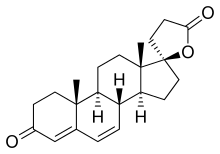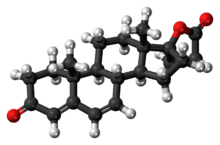Canrenone
Canrenone, sold under the brand names Contaren, Luvion, Phanurane, and Spiroletan, is a steroidal antimineralocorticoid[3][4] of the spirolactone group related to spironolactone which is used as a diuretic in Europe, including in Italy and Belgium.[5][6][7][8] It is also an important active metabolite of spironolactone, and partially accounts for its therapeutic effects.[9][2]
 | |
 | |
| Clinical data | |
|---|---|
| Trade names | Contaren, Luvion, Phanurane, Spiroletan |
| Other names | Aldadiene;[1] SC-9376; RP-11614; 7α-Desthioacetyl-δ6-spironolactone; 6,7-Dehydro-7α-desthioacetylspironolactone; 17-Hydroxy-3-oxo-17α-pregna-4,6-diene-21-carboxylic acid γ-lactone |
| AHFS/Drugs.com | International Drug Names |
| Drug class | Antimineralocorticoid |
| ATC code | |
| Pharmacokinetic data | |
| Protein binding | 95% |
| Elimination half-life | 16.5 hours[2] |
| Identifiers | |
IUPAC name
| |
| CAS Number | |
| PubChem CID | |
| ChemSpider | |
| UNII | |
| ChEMBL | |
| CompTox Dashboard (EPA) | |
| ECHA InfoCard | 100.012.322 |
| Chemical and physical data | |
| Formula | C22H28O3 |
| Molar mass | 340.456 g/mol g·mol−1 |
| 3D model (JSmol) | |
SMILES
| |
InChI
| |
| | |
Medical uses
Canrenone is mainly used as a diuretic.
Canrenone has been found to be effective in the treatment of hirsutism in women.[10]
Pharmacology
Pharmacodynamics
Canrenone is reportedly more potent as an antimineralocorticoid relative to spironolactone, but is considerably less potent and effective as an antiandrogen.[11][12] Similarly to spironolactone, canrenone inhibits steroidogenic enzymes such as 11β-hydroxylase, cholesterol side-chain cleavage enzyme, 17α-hydroxylase, 17,20-lyase, and 21-hydroxylase, but once again, is comparatively less potent in doing so.[13]
| Compound | AR RBA (%) | AR Ki (nM) |
|---|---|---|
| Metribolone | 100 | 1.18 |
| Dihydrotestosterone | 136 | 0.87 |
| Testosterone | 117 | 1.01 |
| Spironolactone | 67.0 | 1.76 |
| Trimethyltrienolone | 14.8 | 8.0 |
| Megestrol acetate | 13.6 | 8.7 |
| Cyproterone acetate | 12.5 | 9.5 |
| Progesterone | 6.6 | 18 |
| Estradiol | 4.9 | 24 |
| Androstenedione | 2.0 | 58 |
| Canrenone | 0.84 | 140 |
| Flutamide | 0.079 | 1200 |
| Cimetidine | 0.00084 | 140,000 |
| Notes: (1) Human skin fibroblasts used for assays. (2) Situation in vivo is different for flutamide and spironolactone due biotransformation. (3) Conflicting findings for spironolactone. Sources: See template. | ||
Pharmacokinetics
The elimination half-life of canrenone is about 16.5 hours.[2]
As a metabolite
Canrenone is an active metabolite of spironolactone, canrenoic acid, and potassium canrenoate, and is considered to be partially responsible for their effects.[9] It has been found to account for approximately 10 to 25% of the potassium-sparing effect of spironolactone,[14] whereas another metabolite, 7α-thiomethylspironolactone (7α-TMS), accounts for around 80% of the potassium-sparing effect of the drug.[15][16][17]
| Compound | Cmax (day 1) | Cmax (day 15) | AUC (day 15) | t1/2 |
|---|---|---|---|---|
| Spironolactone | 72 ng/mL (173 nmol/L) | 80 ng/mL (192 nmol/L) | 231 ng•hour/mL (555 nmol•hour/L) | 1.4 hours |
| Canrenone | 155 ng/mL (455 nmol/L) | 181 ng/mL (532 nmol/L) | 2,173 ng•hour/mL (6,382 nmol•hour/L) | 16.5 hours |
| 7α-TMS | 359 ng/mL (924 nmol/L) | 391 ng/mL (1,006 nmol/L) | 2,804 ng•hour/mL (7,216 nmol•hour/L) | 13.8 hours |
| 6β-OH-7α-TMS | 101 ng/mL (250 nmol/L) | 125 ng/mL (309 nmol/L) | 1,727 ng•hour/mL (4,269 nmol•hour/L) | 15.0 hours |
| Sources: See template. | ||||
History
Canrenone was described and characterized in 1959.[5] It was introduced for medical use, in the form of potassium canrenoate (the potassium salt of canrenoic acid), by 1968.[18]
Society and culture
See also
References
- Jürg Müller (6 December 2012). Regulation of Aldosterone Biosynthesis: Physiological and Clinical Aspects. Springer Science & Business Media. pp. 164–. ISBN 978-3-642-83120-1.
- Gardiner P, Schrode K, Quinlan D, Martin BK, Boreham DR, Rogers MS, Stubbs K, Smith M, Karim A (1989). "Spironolactone metabolism: steady-state serum levels of the sulfur-containing metabolites". J Clin Pharmacol. 29 (4): 342–7. doi:10.1002/j.1552-4604.1989.tb03339.x. PMID 2723123.
- Losert, W; Casals-Stenzel, J; Buse, M (1985). "Progestogens with antimineralocorticoid activity". Arzneimittelforschung. 35 (2): 459–71. PMID 4039568.
- Fernandez, MD; Carter, GD; Palmer, TN (1983). "The interaction of canrenone with oestrogen and progesterone receptors in human uterine cytosol". Br J Clin Pharmacol. 15 (1): 95–101. doi:10.1111/j.1365-2125.1983.tb01470.x. PMC 1427833. PMID 6849751.
- J. Elks (14 November 2014). The Dictionary of Drugs: Chemical Data: Chemical Data, Structures and Bibliographies. Springer. pp. 210–. ISBN 978-1-4757-2085-3.
- Hill, R.A.; Makin, H.L.J.; Kirk, D.N.; Murphy, G.M. (23 May 1991). Dictionary of Steroids. CRC Press. pp. 656–. ISBN 978-0-412-27060-4.
- Romanelli, RG; Gentilini, P (May 2004). "Cross reactivity due to positive canrenone interference". Gut. 53 (5): 772–3. PMC 1774040. PMID 15082604.
- Index Nominum 2000: International Drug Directory. Taylor & Francis. January 2000. pp. 167–. ISBN 978-3-88763-075-1.
- Clark, Michelle A.; Harvey, Richard A.; Finkel, Richard; Rey, Jose A.; Whalen, Karen (15 December 2011). Pharmacology. Lippincott Williams & Wilkins. pp. 286–. ISBN 978-1-4511-1314-3.
- Sobbrio, GA; Granata, A; Panacea, A; Trimarchi, F (1989). "Effectiveness of short term canrenone treatment in idiopathic hirsutism". Minerva Endocrinol. 14 (2): 105–8. PMID 2761494.
- Coelingh Benni, H.J.T.; Vemer, H.M. (15 December 1990). Chronic Hyperandrogenic Anovulation. CRC Press. pp. 152–. ISBN 978-1-85070-322-8.
- Seldin, Donald W.; Giebisch, Gerhard H. (23 September 1997). Diuretic Agents: Clinical Physiology and Pharmacology. Academic Press. pp. 630–. ISBN 978-0-08-053046-8.
- Colby, HD (1981). "Chemical suppression of steroidogenesis". Environ. Health Perspect. 38: 119–27. doi:10.1289/ehp.8138119. PMC 1568425. PMID 6786868.
- Pere Ginés; Vicente Arroyo; Juan Rodés; Robert W. Schrier (15 April 2008). Ascites and Renal Dysfunction in Liver Disease: Pathogenesis, Diagnosis, and Treatment. John Wiley & Sons. p. 229. ISBN 978-1-4051-4370-7.
- Maron BA, Leopold JA (2008). "Mineralocorticoid receptor antagonists and endothelial function". Curr Opin Investig Drugs. 9 (9): 963–9. PMC 2967484. PMID 18729003.
- International Agency for Research on Cancer; World Health Organization (2001). Some Thyrotropic Agents. World Health Organization. pp. 325–. ISBN 978-92-832-1279-9.
- Agusti G, Bourgeois S, Cartiser N, Fessi H, Le Borgne M, Lomberget T (2013). "A safe and practical method for the preparation of 7α-thioether and thioester derivatives of spironolactone". Steroids. 78 (1): 102–7. doi:10.1016/j.steroids.2012.09.005. PMID 23063964.
- William Andrew Publishing (22 October 2013). Pharmaceutical Manufacturing Encyclopedia, 3rd Edition. Elsevier. pp. 804–. ISBN 978-0-8155-1856-3.
- https://www.drugs.com/international/canrenone.html
- https://www.drugs.com/international/potassium-canrenoate.html